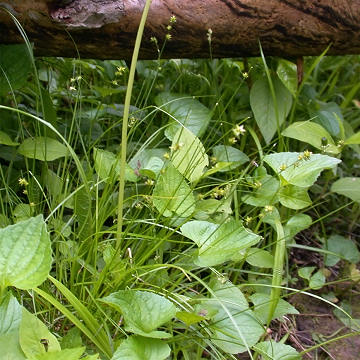

Carex rosea - (image 1 of 4)
Taxonomy
Family: Cyperaceae
Section Phaestoglochin
Once synonymous with Carex convoluta Mack. due to some apparent confusion between this species and C. radiata.
Habitat
Dry to wet woods.
Associates
Distribution
Nova Scotia and southern Quebec west to MN and eastern NE, south to GA, TN, and AR.
Morphology
Plants in dense tufts (cespitose) to 80 cm tall; fertile stems erect, 1.8-2.6 mm thick at the base; leaves slender, the largest 1.8-2.6 mm wide, sheaths tight and not septate-nodulose on the back; spikes 4-7, androgynous (staminate flowers above pistillate), the lateral spikes with a few staminate flowers at the tip; perigynia greenish, radiating in all directions, 2.0-3.4 mm, 2-3 times as long as wide, the beak serrulate-margined; scales obtuse, persistent; stigmas 2, one or twice coiled.
Notes
Fruiting May to June
Wetland indicator: FACU
Although this species keys out in Gleason & Cronquist very close to C. appalachica, the radiate arrangement of the perigynia set it apart quite readily.
Also known as Rosy Sedge, the coiled stigmas are reddish, hence the specific epithet. The similar C. radiata is not quite as robust, has straight stigmas, and is found in more wet depressions than C. rosea but often in the same habitats
References
Curtis, L. 2006. Woodland Carex of the upper Midwest. Lake Villa, IL.
Gleason, Henry A. and A. Cronquist. 1991. Manual of Vascular Plants of
Northeastern United States and Adjacent Canada. Second Ed.
The New York Botanical Garden. Bronx, NY
Swink, F. and G. Wilhelm. 1994. Plants of the Chicago Region.
Indiana Academy of Science. The Morton Arboretum. Lisle, Illinois.
|
© Michael Hough 2010 |